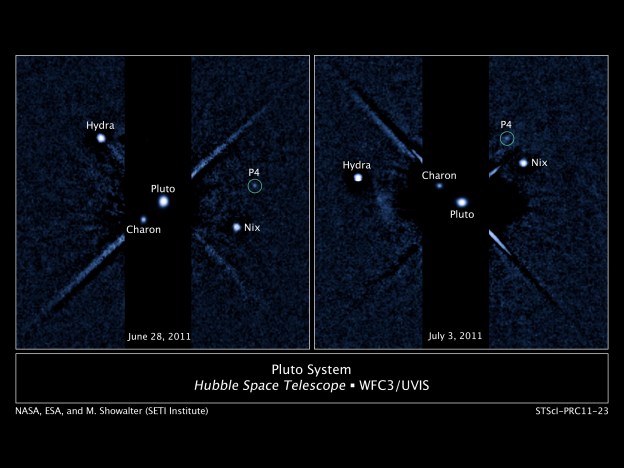 Sure, Pluto received a bit of a demotion when its status as a planet was called into question a few years ago, but that doesn’t mean it stopped giving scientists reasons to study it. And thanks to a recent discovery by the Hubble Space Telescope, we’ve learned that the world-formerly-known-as-planet-Pluto has yet another moon orbiting it.
Sure, Pluto received a bit of a demotion when its status as a planet was called into question a few years ago, but that doesn’t mean it stopped giving scientists reasons to study it. And thanks to a recent discovery by the Hubble Space Telescope, we’ve learned that the world-formerly-known-as-planet-Pluto has yet another moon orbiting it.
So does this mean Pluto’s any closer to regaining its “planet” status? Sadly, no — but it still has astronomers (of both the professional and backyard variety) buzzing.
Temporarily assigned the name “P4,” the new moon joins Charon, Hydra and Nix as the fourth member of Pluto’s satellites. P4 is the smallest of Pluto’s moons, with a diameter of only 8-21 miles, and was discovered while searching for rings around the icy world.
According to NASA researchers, the most important aspect of P4’s discovery is the realization that the powerful Hubble telescope can reveal objects that far away.
“I find it remarkable that Hubble’s cameras enabled us to see such a tiny object so clearly from a distance of more than 3 billion miles (5 billion km),” said program leader Mark Showalter of the SETI Institute.
The study of Pluto and its cosmic neighbors that revealed P4 is part of an ongoing project to gather information before NASA’s “New Horizons” robotic spacecraft reaches the far edge of our solar system. The spacecraft was launched in January 2006, and is expected to reach Pluto in 2015.
“This is a fantastic discovery,” said New Horizons’ principal investigator Alan Stern. “Now that we know there’s another moon in the Pluto system, we can plan close-up observations of it during our flyby.”
Despite the decision to remove Pluto’s “planet” status in 2006, scientists continue to study the frozen world, which is now classified as a “dwarf planet” by the International Astronomical Union. All four of its moons are believed to be the product of a collision between Pluto and another world of similar size back in the formative years of the solar system — the same type of collision believed to have given Earth its own moon, in fact.



